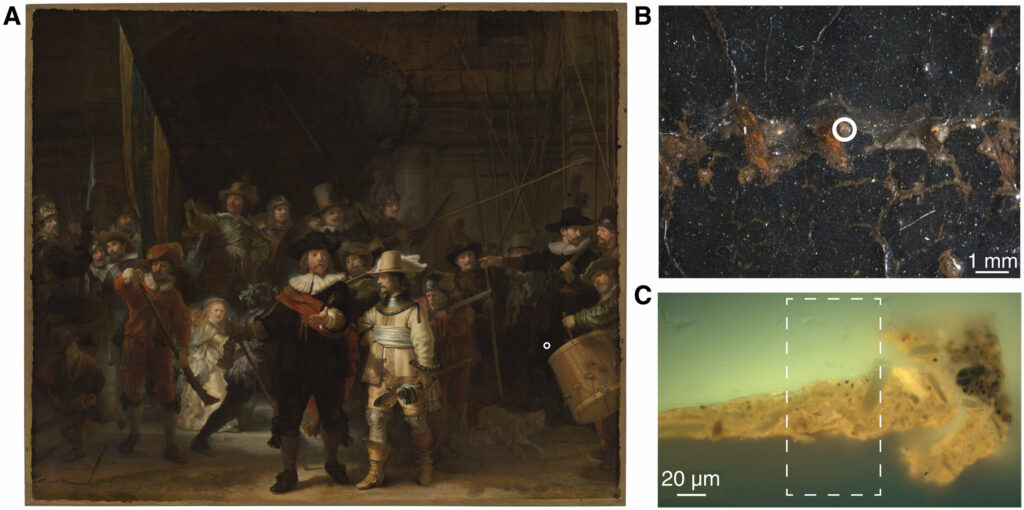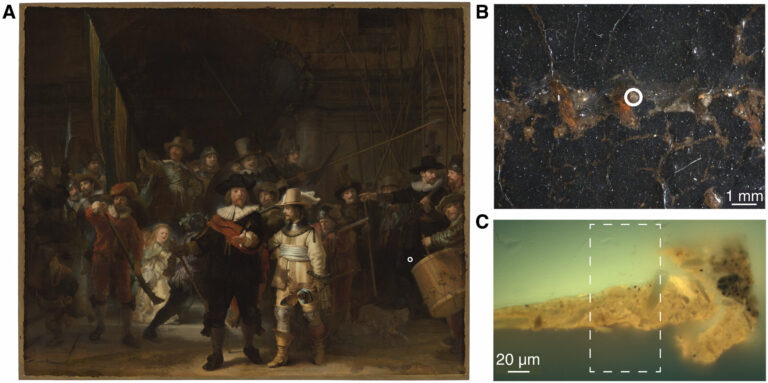Research Reveals Rembrandt’s Innovative Use of Lead-Based Canvas Impregnation in “The Night Watch”
Recent research has brought to light that Rembrandt utilized a lead-containing substance to impregnate the canvas for his renowned 1642 militia painting, “The Night Watch,” even before applying the initial ground layer. This innovative lead-based impregnation stands as a unique practice not previously observed in the works of Rembrandt or his contemporaries. The findings, disclosed in a publication today in Science Advances, underscore Rembrandt’s inventive approach, demonstrating his willingness to explore and adopt novel techniques.

This unexpected revelation stems from Operation Night Watch, an extensive research and conservation initiative representing the most comprehensive study conducted on Rembrandt’s masterpiece. The discovery resulted from sophisticated analyses of an authentic paint sample extracted from the historical painting.
Fréderique Broers, the primary author of the paper and a researcher at the Rijksmuseum, collaborates with professors Katrien Keune (University of Amsterdam), Koen Janssens (University of Antwerp), and Florian Meirer (Utrecht University). Broers’ research is an integral component of the larger research project, “3D Understanding of Degradation Products in Paintings,” affiliated with the Netherlands Institute for Conservation+Art+Science+ (NICAS).
The investigative team, leveraging a combination of X-ray fluorescence and ptychography, identified and visualized sub-microscale chemical compounds in the canvas’s lower layers. The Night Watch paint fragment, sampled at DESY (Deutsches Elektronen-Synchrotron, Hamburg), unveiled the presence of a lead-rich layer beneath the quartz-clay ground layer of the canvas.
Protection against moisture
Earlier research had already established Rembrandt’s use of a quartz-clay ground in “The Night Watch.” In preceding artworks, he had employed double grounds, featuring an initial ground with red earth pigments, followed by a second ground containing lead white. The considerable size of “The Night Watch” may have prompted Rembrandt to seek a more cost-effective, lighter, and flexible alternative for the ground layer.
Another challenge he faced was the intended placement of the large canvas on a damp outer wall of the great hall of the Kloveniersdoelen (musketeers’ shooting range) in Amsterdam. Reports suggested that the conventional method of preparing the canvas with animal glue could falter under humid conditions. A contemporary source on painting techniques, authored by Théodore de Mayerne, proposed lead-rich oil impregnation as an alternative. This may have influenced Rembrandt’s unconventional impregnation method, aimed at enhancing the durability of his masterpiece.
Computational imaging
The identification of the lead-containing “layer” was made possible through the inaugural application of correlated X-ray fluorescence and ptychographic nano-tomography on a historical paint sample. This groundbreaking analysis took place at the PETRA III synchrotron radiation source at DESY. X-ray fluorescence, employed to explore the distribution of relatively heavy elements (calcium and beyond), was complemented by ptychography, a computational imaging technique utilizing experimentally derived datasets. Ptychography has the capability to visualize even the lightest elements and organic fractions.
Upon scrutinizing the microsample extracted from The Night Watch, it was observed that a homogeneous layer of dispersed lead existed in the ground layer on the side closest to the canvas support. Given that lead components were unexpected in the quartz-clay ground layer, this observation posed an intriguing puzzle. The findings were then integrated with the lead distribution map of the entire Night Watch, generated through X-ray fluorescence scanning of the painting in the Rijksmuseum’s Gallery of Honour.
This comprehensive map unveils the widespread presence of lead across the painting, suggesting application through extensive semi-circular brushstrokes and supporting the hypothesis of an impregnation procedure. Notably, the lead distribution map even displays an imprint of the original strainer onto which the canvas was stretched during the application of preparatory layers. This advancement brings us closer to unraveling Rembrandt’s creative process in painting The Night Watch and understanding its present condition.
This article is republished from PhysORG under a Creative Commons license. Read the original article.
Do not forget to share your opinion with us to provide you with the best posts !




0 Comments